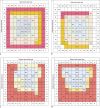The NIAID/RNCP Biodosimetry Program: An Overview
- PMID: 37742625
- PMCID: PMC10946631
- DOI: 10.1159/000534213
The NIAID/RNCP Biodosimetry Program: An Overview
Abstract
Established in 2004, the Radiation and Nuclear Countermeasures Program (RNCP), within the National Institute of Allergy and Infectious Diseases (NIAID), National Institutes of Health has the central mission to advance medical countermeasure mitigators/therapeutics, and biomarkers and technologies to assess, triage, and inform medical management of patients experiencing acute radiation syndrome and/or the delayed effects of acute radiation exposure. The RNCP biodosimetry mission space encompasses: (1) basic research to elucidate novel approaches for rapid and accurate assessment of radiation exposure, (2) studies to support advanced development for US Food and Drug Administration (FDA) clearance of promising triage or treatment devices/approaches, (3) characterization of biomarkers and/or assays to determine degree of tissue or organ dose that can predict outcome of radiation injuries (i.e., organ failure, morbidity, and/or mortality), and (4) outreach efforts to facilitate interactions with researchers developing cutting edge biodosimetry approaches. Thus far, no biodosimetry device has been FDA cleared for use during a radiological/nuclear incident. At NIAID, advancement of radiation biomarkers and biodosimetry approaches is facilitated by a variety of funding mechanisms (grants, contracts, cooperative and interagency agreements, and Small Business Innovation Research awards), with the objective of advancing devices and assays toward clearance, as outlined in the FDA's Radiation Biodosimetry Medical Countermeasure Devices Guidance. The ultimate goal of the RNCP biodosimetry program is to develop and establish accurate and reliable biodosimetry tools that will improve radiation preparedness and ultimately save lives during a radiological or nuclear incident.
Keywords: Biodosimetry assays; Definitive dose; Mechanisms; Predictive biodosimetry; Resources; Triage.
© 2023 The Author(s). Published by S. Karger AG, Basel.
Conflict of interest statement
The authors declare no conflict of interest.
Figures





References
-
- Azizova TV, Osovets SV, Day RD, Druzhinina MB, Sumina MV, Pesternikova VS, et al. . Predictability of acute radiation injury severity. Health Phys. 2008;94:255–63. - PubMed
-
- Bacarella N, Ruggiero A, Davis AT, Uberseder B, Davis MA, Bracy DP, et al. . Whole body irradiation induces diabetes and adipose insulin resistance in nonhuman primates. Int J Radiat Oncol Biol Phys. 2020;106:878–86. - PubMed
Publication types
MeSH terms
Substances
LinkOut - more resources
Full Text Sources
Medical

